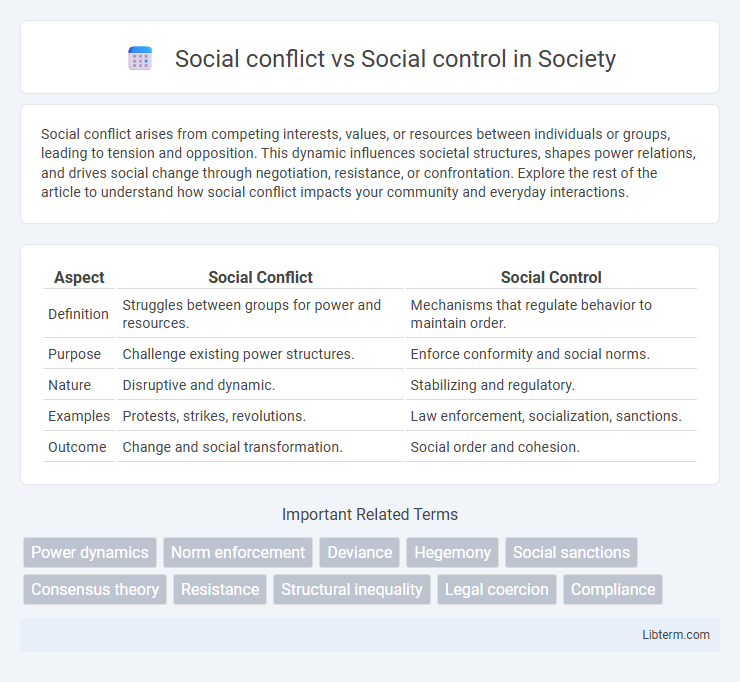Social conflict arises from competing interests, values, or resources between individuals or groups, leading to tension and opposition. This dynamic influences societal structures, shapes power relations, and drives social change through negotiation, resistance, or confrontation. Explore the rest of the article to understand how social conflict impacts your community and everyday interactions.
Table of Comparison
| Aspect | Social Conflict | Social Control |
|---|---|---|
| Definition | Struggles between groups for power and resources. | Mechanisms that regulate behavior to maintain order. |
| Purpose | Challenge existing power structures. | Enforce conformity and social norms. |
| Nature | Disruptive and dynamic. | Stabilizing and regulatory. |
| Examples | Protests, strikes, revolutions. | Law enforcement, socialization, sanctions. |
| Outcome | Change and social transformation. | Social order and cohesion. |
Understanding Social Conflict
Understanding social conflict involves analyzing how power struggles between groups shape societal structures and influence inequality. Social conflict theory highlights the tension arising from competing interests, resources, and social norms, emphasizing how dominant groups maintain control. This perspective contrasts with social control, which focuses on mechanisms and institutions designed to regulate individual behavior and ensure societal stability.
Defining Social Control
Social control refers to the mechanisms, strategies, and institutions societies use to regulate individual and group behavior, ensuring conformity to established norms and laws. It involves formal tools like laws and sanctions as well as informal methods such as socialization and peer pressure. Unlike social conflict, which emphasizes power struggles and inequality, social control prioritizes maintaining order and stability within a social system.
Historical Perspectives on Social Conflict and Control
Historical perspectives on social conflict emphasize class struggles, power imbalances, and systemic inequalities shaping societal change, as seen in Marxist theory and the works of Weber. Social control is framed through mechanisms like laws, norms, and institutional authority that maintain order and suppress deviance to preserve stability. The dialectic between conflict and control highlights how power dynamics evolve, with social control often serving the interests of dominant groups to mitigate disruptive conflicts.
Causes of Social Conflict
Social conflict arises primarily from competition over scarce resources, power imbalances, and opposing interests among different social groups. Inequality, social injustice, and cultural differences often exacerbate tensions, leading to disputes and unrest within societies. Understanding these root causes is essential for developing effective strategies in social control to maintain order and cohesion.
Mechanisms of Social Control
Mechanisms of social control include formal sanctions such as laws and regulations enforced by institutions like the police and judiciary, as well as informal controls like social norms, peer pressure, and family expectations that regulate individual behavior. These mechanisms maintain social order by discouraging deviance and encouraging conformity, contrasting with social conflict theories that emphasize power struggles and inequalities driving societal change. Structural functionalists highlight social control as essential for stability, while conflict theorists argue it can perpetuate dominance by privileged groups.
Social Conflict vs Social Control: Key Differences
Social conflict refers to the tension and struggle between different social groups competing for resources, power, and status, highlighting inequalities and systemic issues within society. Social control involves mechanisms, such as laws, norms, and institutions, designed to regulate individual behavior and maintain social order. The key differences lie in their functions: social conflict emphasizes change and resistance to inequality, while social control prioritizes stability and conformity.
The Role of Power in Conflict and Control
Power dynamics play a crucial role in social conflict by determining which groups or individuals can challenge existing social structures and push for change. In social control, power is exercised through institutions, laws, and norms to maintain order and enforce conformity, often benefiting dominant groups. The interplay between power in conflict and control shapes societal stability and transformation by balancing resistance and regulation.
Social Institutions and Their Influence
Social conflict theory examines how social institutions perpetuate inequalities by maintaining power dynamics and fostering competition among groups. Social control focuses on the mechanisms institutions use to enforce norms, regulate behavior, and maintain social order. Both perspectives reveal how institutions like the legal system, education, and family shape societal structure and influence individual actions.
Resolving Social Conflict through Social Control
Resolving social conflict through social control involves implementing structured norms, laws, and regulations to maintain societal order and address underlying disputes. Effective social control mechanisms such as legal systems, law enforcement agencies, and community mediation help reduce tensions by enforcing rules and promoting cooperation. These tools work to balance competing interests, prevent escalation of conflicts, and foster social stability within diverse populations.
Impacts on Society: Harmony or Tension?
Social conflict generates tension by highlighting inequalities and power struggles, often leading to social change and increased awareness of injustices. Social control promotes harmony by enforcing norms and rules that maintain order, but excessive control can suppress individuality and provoke resistance. Balancing these forces shapes societal stability and the dynamic between conflict-driven progress and regulation-driven cohesion.
Social conflict Infographic

 libterm.com
libterm.com